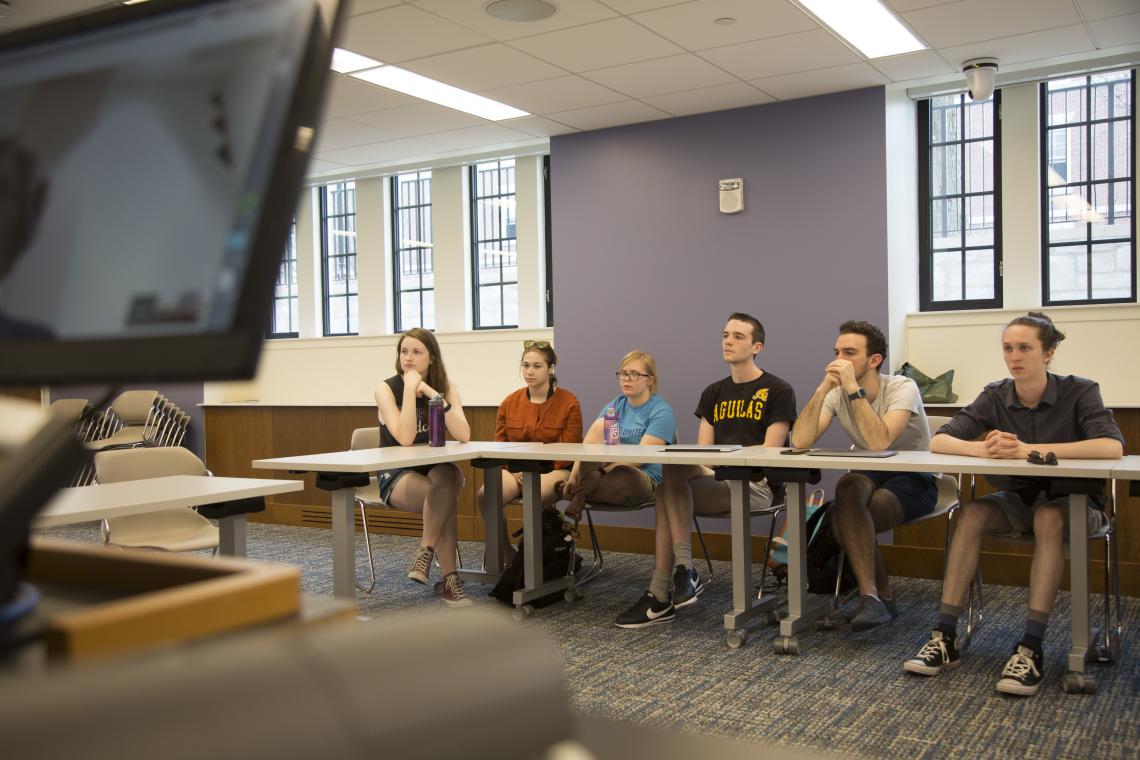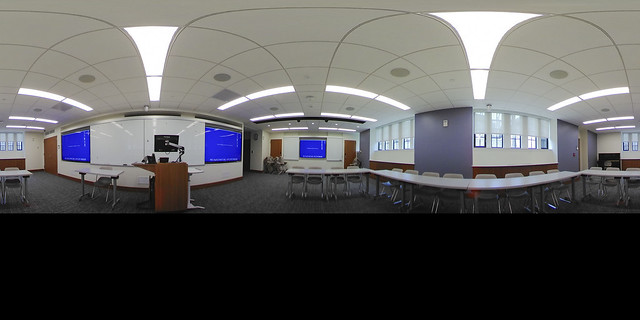The style of classroom popularly known as an active learning environment continues to grow in popularity at Northwestern. As the number of active learning rooms increase on campus, more and more students and instructors are taking advantage of the opportunities provided by these cooperative learning spaces to encourage collaboration and peer teaching.
To really understand how active learning rooms are being utilized across campus, Digital Learning has partnered with two Weinberg faculty members and a School of Communications graduate student instructor. All three are teaching in an active learning space for the first time this quarter. This series tells their stories – how they started teaching in an active learning space and how it has influenced their style of instruction.
Next up is Dr. Elizabeth Hunter, whose phenomenally titled class, “Violence and Magic on Shakespeare's Stage,” takes place in Willard Hall’s large active learning classroom, B72. This theater history course utilizes both lecture and performance to ensure students emerge from their 10-week session with an understanding of the theory and practice of portraying violence and/or magic on stage.
On the day I attended class, Hunter and her students held a videoconference with Ben Lumsden, a tech industry expert in London on his experience using motion capture technology [ed. if unfamiliar, Google “Andy Serkis” and “Imaginarium” and prepare to be amazed] to enhance the Royal Shakespeare Company’s 2016 production of The Tempest. As I watched Hunter’s students asking deep, pointed questions of their expert, I could see the gears turning as they thought about how to apply these kinds of innovative approaches to their own work.
After class, I spoke with Hunter to learn more about how the active learning space in Willard Hall has influenced the class and its experience for her students.
What does the material of your class cover?
We look at how violence and magic are handled from a practical standpoint onstage. It's really difficult to stage violence and magic. There are a lot of practical elements students don't necessarily realize until they have to get a scene on its feet themselves, and they’re like, “Oh, wait a minute. Blood is really messy!” So in addition to how an on-stage use of blood reflects back on the text itself, there are also all these practical considerations directors have to manage.
I structured the class around theoretical concepts and a fair amount of project-based or practice-based learning. This combination encourages students to use the theory that we're working on in order to create a product that somebody can come and see. In our case, it's a show; in my other classes, students have created digital adaptations or learning tools, or they’ve written a proposal for a learning tool that somebody could use.
What does a typical class session look like? Which of technologies in the room do you utilize?
Honestly, there isn’t an element of the room I don’t use. Every day is different, which is one of the reasons that Willard B72 has been valuable for us—it's so movable and modular.
Some days we’ll do a close read of a scene, often mapping ideas onto Post-it Notes and putting them up around the room. Other days we rehearse the scenes students will put up at the end of the quarter. There are also class periods when I give a conventional lecture with a presentation that needs to be up on monitors. The space accommodates all of these structural needs beautifully.
Theatre lighting setup in Willard B72
When I visited, the students talked with an expert in motion capture that was used in a recent live production. What did they take away from that opportunity?
Bringing in outside speakers gives students the opportunity to interface with someone doing similar work. It's a way to connect their learning to the outside world, and that connection encourages them to invest more in the concepts we're working on in class.
At the end of the quarter, the students will stage a 4–6 minute scene from King Lear or Macbeth. Because each scene needs to stage violence or magic in some way, it’s helpful for them to talk to someone who’s done it before in an interesting way.
As a prelude to Ben’s in-class appearance, we analyzed the Royal Shakespeare Company’s use of motion capture technology for their production of The Tempest. Our discussion centered on how students would choose specific moments in a text to portray magic or violence, and how these moments align with the aesthetic vocabulary that defines the overall production. Conversations like the one they had with Ben help students think concretely about how they too can make these connections.
Hunter’s class videoconferencing with an industry expert in London
What would you say are the advantages of this space as opposed to a more traditional classroom?
The room’s size and versatility. The traditional model of what a classroom looks like, with rows of seats and an authority at the front, doesn't support the kind of active learning that interests me.
But B72 can transform radically over the course of one 80-minute class. For example, some days I need to start out siting in rows for a lecture, then I need the students to work in groups, then I need all the tables to go away so that we can do an activity on our feet. So while the square footage alone adds significant value, even more important is B72’s flexibility. There are a lot of big spaces on campus, but the desks are often bolted to the floor—there's not an option for that kind of space to be versatile.
Check out the room:



